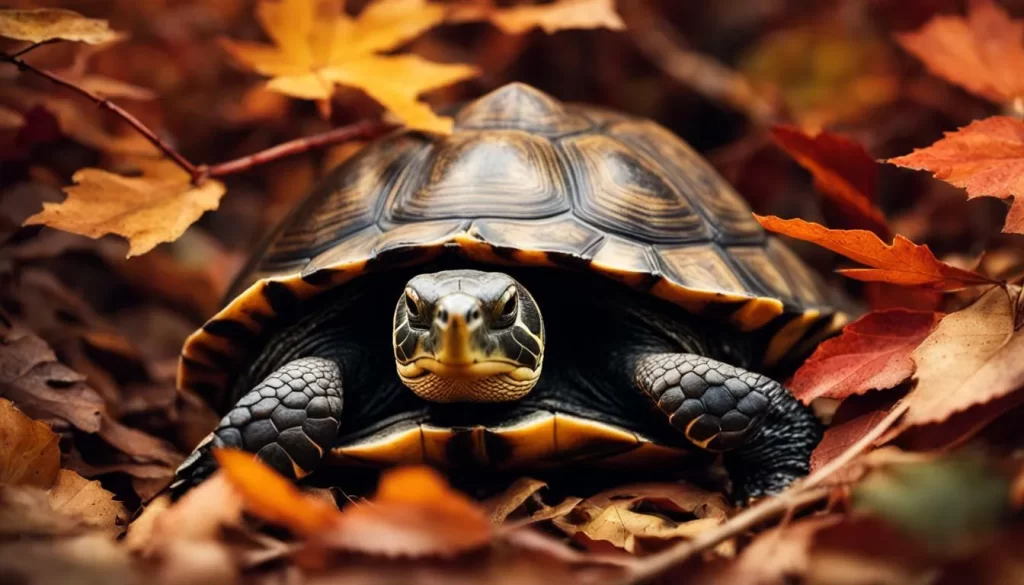If you’re wondering whether your pet turtle can enjoy a crisp serving of lettuce, you’ve come to the right place. Let’s explore the dietary needs of pet turtles and whether lettuce is a suitable addition to their meal plan.
Factual data: Lettuce can be safe for pet turtles to eat, but certain types, like iceberg lettuce, have very little nutritional value and should not be the main source of their diet.
Other lettuce varieties, such as romaine and radicchio, are nutritious and can be fed to turtles. It is important to wash lettuce thoroughly to remove any pesticides or chemicals before offering it to a turtle.
Turtles should also be provided with a variety of other vegetables, insects, and meat to ensure a balanced diet. Lettuce should be fed in moderation and not be the only food offered to turtles.
Key Takeaways:
- Not all lettuce varieties are suitable for pet turtles. Iceberg lettuce, for example, lacks nutrition and should be avoided as a primary food source.
- Romaine and radicchio lettuce are nutritious options that can be included in a turtle’s diet.
- Thoroughly wash lettuce before offering it to your turtle to remove any harmful substances.
- Turtles require a varied diet that includes vegetables, insects, and meat to meet their nutritional needs.
- Lettuce should be fed to turtles in moderation and should not be the sole food provided.
By understanding the dietary needs and preferences of your pet turtle, you can ensure they receive a balanced and nutritious diet.
Lettuce can be a part of their meal plan, but it should be supplemented with other foods to provide the essential nutrients they require.
Understanding the Turtle Diet
Before delving into whether turtles can eat lettuce, it’s essential to understand their overall dietary needs.
Turtles are omnivorous creatures, meaning they eat both plant matter and animal protein. Their diet should be diverse and balanced to ensure proper nutrition and overall health.
Turtles require a combination of vegetables, fruits, insects, and meat in their diet. Leafy green vegetables, such as lettuce, are an important component of their plant-based intake.
However, it is crucial to choose the right lettuce varieties, as not all types provide the necessary nutrition.
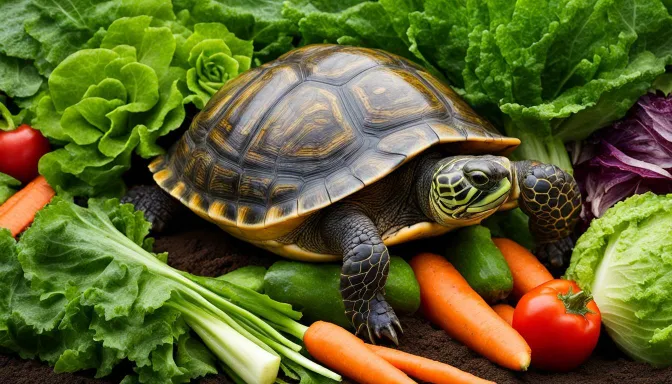
Lettuce varieties like iceberg lettuce have limited nutritional value and should not be the main source of a turtle’s diet.
Instead, opt for nutrient-rich options like romaine and radicchio. These varieties offer essential vitamins and minerals that support a turtle’s overall well-being.
When feeding lettuce to your pet turtle, it’s important to wash it thoroughly. This ensures the removal of any pesticides or chemicals that may be present, reducing the risk of harm to your turtle.
Remember that lettuce should be offered in moderation and should not be the sole food source for your turtle.
Providing a variety of vegetables, insects, and meat is crucial for meeting their dietary needs and promoting optimal health.
The Nutritional Value of Lettuce for Turtles
Lettuce can be a part of your pet turtle’s diet, but not all lettuce varieties offer the same nutritional benefits.
While some types of lettuce, like iceberg lettuce, have very little nutritional value and should not be the main source of their diet, others, such as romaine and radicchio, are more nutritious and can be fed to turtles in moderation.
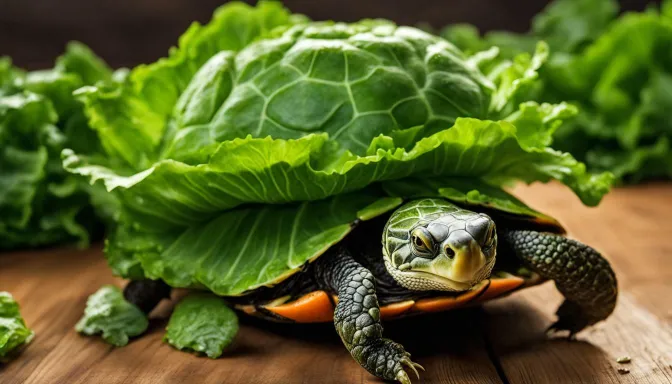
When feeding lettuce to turtles, it is essential to wash it thoroughly to remove any pesticides or chemicals that may be present.
This ensures that the lettuce is safe for consumption and prevents any potential harm to your pet turtle’s health.
Additionally, it is important to offer turtles a balanced diet by including a variety of other vegetables, insects, and meat.
Feeding lettuce to turtles should be done in moderation and not be the sole food offered to them.
While lettuce can provide some essential nutrients, it is important to remember that turtles require a diverse range of foods to meet their nutritional needs.
By offering a variety of foods, you can ensure that your pet turtle receives all the necessary nutrients for optimal health.
| Lettuce Variety | Nutritional Benefits |
|---|---|
| Romaine | Rich in vitamin A, vitamin K, and fiber |
| Radicchio | Provides antioxidants and essential minerals like iron |
| Iceberg | Contains little nutritional value |
In conclusion, while lettuce can be included in a pet turtle’s diet, it should not be the sole focus.
Providing a variety of nutritious foods, including different lettuce varieties, ensures that your turtle receives a well-rounded and balanced diet.
Remember to always wash lettuce thoroughly and feed it in moderation to maintain your pet turtle’s health and well-being.
Safe Lettuce Varieties for Turtles
When it comes to feeding lettuce to your pet turtle, opting for specific varieties ensures they receive the necessary vitamins and minerals.
While iceberg lettuce may be a common staple in human salads, it offers little nutritional value for turtles and should be avoided as a primary food source.
Instead, consider incorporating lettuce varieties that are rich in nutrients, such as romaine and radicchio.
These leafy greens provide essential vitamins like A, K, and C, which are vital for maintaining good health in turtles.
Romaine lettuce, in particular, is a popular choice among turtle owners due to its high nutritional content.
Radicchio, with its vibrant color and slightly bitter taste, is also a great option to add variety to your turtle’s diet.
It is important to note that regardless of the lettuce variety, thorough washing is crucial before offering it to your pet turtle.
This helps remove any pesticides or chemicals that may be present. Additionally, remember that lettuce should not be the sole component of your turtle’s diet.
To ensure a balanced nutritional intake, supplement their meals with a diverse range of vegetables, insects, and meat.
Safe Lettuce Varieties for Turtles
| Lettuce Variety | Nutritional Value |
|---|---|
| Romaine Lettuce | Rich in vitamins A, K, and C |
| Radicchio | High in vitamins and adds variety to the diet |
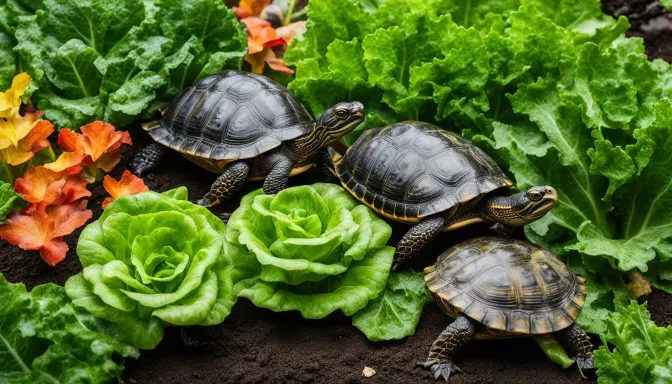
Remember to offer lettuce to your turtle in moderation. While it can be a healthy addition to their diet, it should not be the sole source of nutrients.
By providing a well-rounded menu that includes a variety of foods, you can ensure your pet turtle enjoys a balanced and nutritious diet.
Preparing Lettuce for Turtles
Feeding lettuce to your turtle requires proper preparation to ensure their safety and well-being.
Before offering lettuce to your pet, it is crucial to wash it thoroughly to remove any potential traces of pesticides or chemicals.
Cleaning the lettuce ensures that your turtle does not ingest harmful substances that could negatively impact its health.
When preparing lettuce, start by removing any wilted or damaged leaves. Discard these as they may be unsuitable for consumption.
Next, rinse the lettuce under cool running water, gently rubbing the leaves to remove any dirt or debris. It is highly recommended to use organic lettuce whenever possible to minimize the risk of pesticide exposure.
Once the lettuce is clean, pat it dry with a paper towel or allow it to air dry before serving it to your turtle.
Turtle-Friendly Vegetables
In addition to lettuce, there are several other turtle-friendly vegetables that you can include in your pet’s diet.
These vegetables provide essential nutrients and variety, ensuring a balanced diet for your turtle. Some suitable options include:
- Leafy greens such as kale, spinach, and collard greens
- Other vegetables like carrots, bell peppers, and squash
- Edible plants like dandelion greens and watercress
By incorporating a mix of these vegetables alongside lettuce, you can provide your turtle with a diverse range of nutrients.
Remember to offer a variety of foods, including insects and meat, to meet your turtle’s dietary needs.
| Lettuce Variety | Nutritional Value | Safe for Turtles? |
|---|---|---|
| Romaine | Rich in vitamins A and K, as well as fiber | Yes |
| Iceberg | Low nutritional value, mainly water | No, avoid as a primary food source |
| Radicchio | Contains antioxidants and fiber | Yes |
Remember, while lettuce can be a part of your turtle’s diet, it should not be the main source of nutrition.
Offer lettuce and other vegetables in moderation, ensuring a well-rounded diet that meets your pet’s nutritional needs.
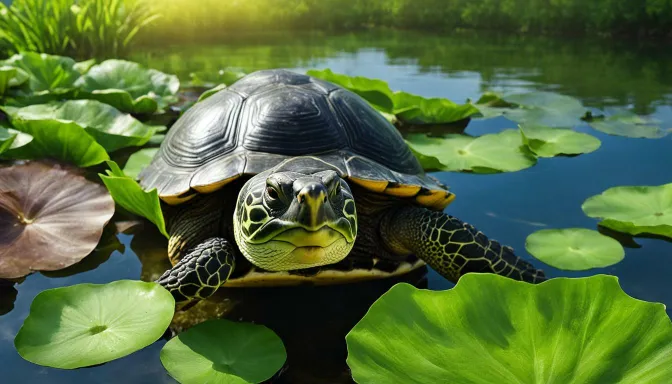
While lettuce can be part of a turtle’s diet, it should not be the sole food source – a balanced diet is crucial for their overall health.
Turtles have specific dietary needs that must be met to ensure their well-being. In addition to lettuce, it is important to provide turtles with a variety of other vegetables, insects, and meat.
When it comes to lettuce, not all varieties are created equal in terms of nutritional value. While iceberg lettuce may be a common choice, it offers very little in terms of nutrients for turtles.
Instead, opt for lettuce varieties like romaine and radicchio, which are more nutritious and can be included in their diet.
Before feeding lettuce to your turtle, it is important to wash it thoroughly to remove any pesticides or chemicals.
This will ensure that your turtle is not exposed to any harmful substances. Additionally, lettuce should be fed in moderation and not be the only food offered to turtles.
A variety of other vegetables, such as kale, collard greens, and carrots, should also be included to provide a well-rounded diet.
Table: Recommended Vegetables for Turtles
| Vegetable | Nutritional Benefits |
|---|---|
| Romaine Lettuce | Rich in vitamins A, C, and K |
| Radicchio | High in fiber and antioxidants |
| Kale | Excellent source of calcium and vitamin C |
| Collard Greens | High in vitamins and minerals |
| Carrots | Rich in beta-carotene and vitamin A |
A balanced turtle diet should also include a variety of protein sources, such as insects and meat. Popular choices include mealworms, crickets, and cooked lean meats like chicken or fish.
These protein sources help turtles meet their nutritional needs and support their growth and overall health.
Remember, while lettuce can be a part of a turtle’s diet, it should not be the main focus. Providing a varied and balanced diet that includes a mix of vegetables, protein, and other essential nutrients is key to keeping your pet turtle healthy and happy.
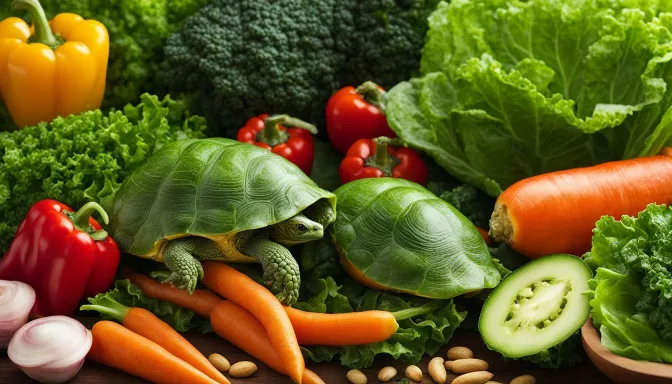
When it comes to feeding lettuce to your pet turtle, remember that moderation is key. While lettuce can be safe for turtles to eat, it should not make up the majority of their diet.
Some lettuce varieties, such as iceberg lettuce, have very little nutritional value and should be avoided as the main source of food for your turtle.
Instead, opt for nutritious lettuce varieties like romaine and radicchio. These types of lettuce contain essential vitamins and minerals that can contribute to your turtle’s overall health.
Before offering lettuce to your turtle, make sure to wash it thoroughly to remove any pesticides or chemicals that may be harmful to their well-being.
While lettuce can be a part of your turtle’s diet, it’s important to provide them with a balanced and diverse range of foods.
In addition to vegetables, turtles also benefit from consuming insects and meat. Offering a variety of foods ensures that they receive all the nutrients they need to thrive.
| Lettuce Variety | Nutritional Benefits |
|---|---|
| Romaine | High in fiber, calcium, and vitamins A and K. |
| Radicchio | Contains antioxidants and vitamins C and E. |
Remember, lettuce should be fed in moderation and not be the sole food source for your turtle. By offering a varied diet and ensuring that lettuce is just one component, you can provide your pet turtle with a healthy and balanced nutritional plan.

In addition to lettuce, there are numerous other foods that are safe and beneficial for your pet turtle to enjoy.
Providing a varied diet is essential to meet their nutritional needs and keep them healthy. Let’s take a look at some of the recommended foods:
- Leafy greens: Apart from lettuce, turtles can also enjoy other leafy greens like kale, spinach, and collard greens. These are packed with essential vitamins and minerals that contribute to their overall well-being.
- Vegetables: Turtles can benefit from a range of vegetables such as carrots, bell peppers, and squash. These provide additional nutrients and add variety to their diet.
- Insects: Protein is an important part of a turtle’s diet, and insects like crickets, mealworms, and earthworms offer a great source. They also provide stimulation and promote natural foraging behavior.
- Meat: Some turtle species, like the red-eared slider, require animal-based protein in their diet. Offer them lean sources of meat such as fish, shrimp, or even cooked chicken in small amounts.
- Fruits: While fruits should be given sparingly due to their high sugar content, occasional treats like berries, melons, and apples can be a tasty addition to your turtle’s diet.
Remember, it is crucial to provide a balanced diet by offering a variety of foods. This ensures that your turtle receives all the necessary nutrients required for their healthy growth and development.
Monitor their feeding habits and adjust the portion sizes accordingly to prevent overfeeding and maintain a healthy weight.
Proper nutrition is vital for the well-being of your pet turtle. Consult a veterinarian familiar with reptiles to get personalized recommendations and guidance on creating a suitable diet plan for your specific turtle species.
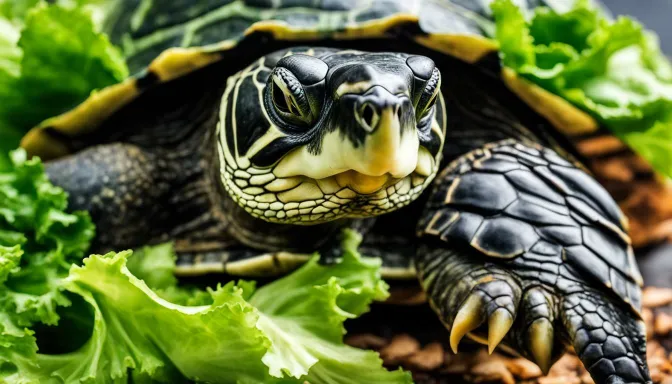
| Food | Nutritional Benefits |
|---|---|
| Lettuce (romaine) | High in fiber, vitamins A and C |
| Kale | Rich in vitamin K, calcium, and antioxidants |
| Spinach | Good source of iron, calcium, and vitamin E |
| Carrots | High in vitamin A and fiber |
| Crickets | Excellent source of protein and essential amino acids |
Conclusions About Feeding Lettuce to Pet Turtles
Feeding lettuce to pet turtles can be done safely and nutritionally if certain guidelines are followed.
While turtles can consume lettuce, it is important to note that not all varieties offer the same nutritional value. Iceberg lettuce, for example, has very little nutritional content and should not be the main source of their diet.
Other lettuce varieties, such as romaine and radicchio, are more nutritious and can be fed to turtles.
When offering lettuce to your pet turtle, it is crucial to wash it thoroughly before feeding. This helps remove any harmful substances, such as pesticides or chemicals, that may be present on the leaves.
Additionally, remember that lettuce should not be the only food provided to turtles. They require a balanced diet that includes a variety of vegetables, insects, and meat to meet their nutritional needs.
It is recommended to feed lettuce in moderation to pet turtles. While it can be a part of their diet, it should not be the sole focus.
Turtles need a diverse range of foods to ensure they receive the necessary nutrients. By offering a variety of turtle-friendly vegetables, along with other recommended foods, you can help maintain their overall health and well-being.
Remember, providing a balanced and nutritious diet is essential for the overall health of pet turtles.
By following these guidelines and offering a variety of foods, including safe lettuce varieties, you can ensure your turtle receives the nutrition it needs to thrive.
Table: Recommended Lettuce Varieties for Pet Turtles
| Lettuce Variety | Nutritional Value |
|---|---|
| Romaine | Rich in fiber, vitamins A and K |
| Radicchio | Contains antioxidants and vitamins B and C |
| Butterhead | Provides folate, iron, and potassium |
Final Thoughts
In conclusion, while pet turtles can eat lettuce, it should be part of a diverse diet that includes other vegetables, insects, and meat to meet their nutritional needs.
Lettuce, especially iceberg lettuce, is low in nutritional value and should not be the main source of food for turtles.
However, certain lettuce varieties like romaine and radicchio can be fed to turtles as they contain essential nutrients.
When feeding lettuce to turtles, it is crucial to wash it thoroughly to remove any pesticides or chemicals that could be harmful to their health.
Additionally, offering a variety of other vegetables, such as kale, spinach, and carrots, along with insects like mealworms and crickets, can provide turtles with the necessary vitamins and minerals they need to thrive.
While lettuce can be included in a turtle’s diet, it should be fed in moderation. Lettuce alone should not constitute the majority of their food intake.
Providing a balanced diet that includes a mix of vegetables, insects, and occasional meat is vital for the overall health and well-being of pet turtles.
Remember to consult a veterinarian or reptile expert for specific dietary recommendations based on your turtle’s species and individual needs.
Frequently Asked Questions
Q: Can a turtle survive on just lettuce?
A: No, turtles require a varied diet that includes protein (such as insects or fish for many species), calcium, and other nutrients which lettuce alone cannot provide. Relying solely on lettuce can lead to nutritional deficiencies.
Q: Can you feed turtles iceberg lettuce?
A: It’s not recommended to feed turtles iceberg lettuce regularly. While it’s not toxic, iceberg lettuce has little nutritional value and doesn’t provide the nutrients turtles need.
Q: Can turtles eat store bought lettuce?
A: Yes, turtles can eat store-bought lettuce, but it’s better to opt for dark leafy greens like romaine or red leaf lettuce rather than iceberg. Always wash it thoroughly to remove pesticides or contaminants.
Q: What lettuce can turtles not have?
A: Turtles should avoid iceberg lettuce as it offers little nutritional value. It’s not harmful in small amounts, but it shouldn’t be a staple in their diet.
Q: How do you feed a turtle lettuce?
A: You can feed a turtle lettuce by washing it thoroughly, tearing it into manageable pieces, and placing it in their habitat. Some turtles might prefer it slightly submerged in water.
Q: Can red-eared slider turtles eat lettuce?
A: Yes, red-eared sliders can eat lettuce, particularly darker varieties like romaine. However, it should be part of a varied diet that includes other greens, protein, and calcium sources.
Q: Why won’t my turtle eat lettuce?
A: Turtles might refuse lettuce for several reasons including illness, stress, or they might simply prefer other foods. If a turtle consistently refuses food, it may be best to consult a veterinarian.
Q: Can a turtle eat lettuce everyday?
A: While turtles can eat lettuce regularly, they need a varied diet for optimal health. It’s best to offer lettuce as part of a rotation with other greens and appropriate foods for the species.
Q: Can wild turtles eat lettuce?
A: While wild turtles can consume lettuce if offered, their natural diet varies depending on the species and environment. Lettuce is not naturally part of their diet in the wild.
Q: Can baby turtles eat lettuce?
A: Baby turtles can eat small amounts of lettuce, but they require more protein in their diet compared to adult turtles. It’s essential to provide a balanced diet suitable for their growth and development.




